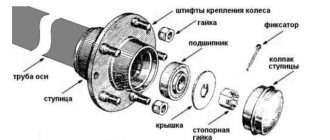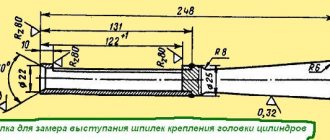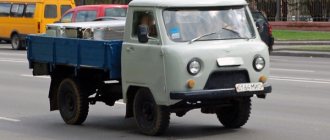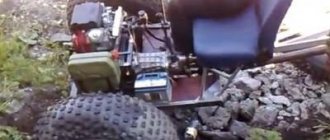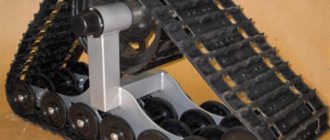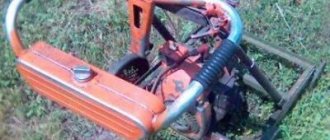Since its invention, the differential mechanism remains one of the most important components of a car and equally difficult for the average person to understand. Through this gearbox, torque from the power unit is transmitted to the wheels, thereby setting them in motion. However, there are a number of cases when the differential needs to be temporarily disabled by removing it from this simple chain using auxiliary devices. This procedure is called differential locking, and to understand it, let’s consider the operating principle of the unit itself.
Objectives and principle of operation of the differential
In the absence of additional devices, both wheels of the car, located on the same axis, would rotate at the same speed. This would entail a number of operational problems, mainly related to handling. Side effects include increased and uneven tire consumption, additional load on suspension elements, and understeer. The differential made it possible to unevenly distribute the rotational speed received by the wheels from the driveshaft.
In real operating conditions, car wheels can move at different speeds in several cases:
Subscribe to our Telegram channel
- when turning, when the outer wheel has to cover a greater distance than the outer one;
- on an uneven road, when the left and right wheels move on a surface with different terrain.
All the features described above are not of particular importance for the driven axle shafts, since they are actually not connected to each other and rotate independently. But the driving pair receives energy from the gearbox; each wheel from it is rigidly connected to the transmission, so curved movement is difficult.
The differential, which makes the drive wheels relatively independent of each other, is used in both trucks and passenger vehicles, both in single-wheel drive and all-wheel drive models. In the latter, the distribution gearbox also controls the balance of forces between the axles. It is most often located in the rear of the car and is connected to the driveshaft. There are three types of this unit:
- open differential;
- limited slip differential;
- differential with lock.
Depending on the type of design of the unit, the nature of the mechanism for transmitting force to the wheels differs. If a situation arises when one of the wheels in a pair loses traction (gets on ice or dirt), the gearbox will direct all the torque to this axle shaft. This will lead to slipping of the wheel that has lost reliable support. In this case, the so-called differential lock is needed: it temporarily disables the tricky unit so that the rotating force is distributed equally between the axle shafts.
What is a differential lock in the video:
Why block him?
In certain situations this is necessary. To make it clearer, let's look at everything in order. If a car turns sharply or goes over rough terrain, its drive wheels travel different lengths. For example, when turning, the path of the outer wheel will be longer, and the path of the inner wheel will be shorter. Previously, when car speeds were low, this circumstance did not particularly worry anyone. But gradually the speed of the cars increased, and problems began to arise:
- tires wear unevenly;
- handling is seriously degraded.
All this happens due to the fact that the torque on the drive wheels of the car is always the same. Therefore, it became necessary to separate the drive wheels so that each of them had its own torque. This task is performed by the VAZ 2107 differential. If the road is smooth, there are no problems with this unit. But as soon as the car finds itself on rough terrain with the differential engaged, the wheels begin to slip, and driving the car becomes much more difficult. It is in this situation that the driver should lock the differential to increase the vehicle's maneuverability.
Differential lock types
Manufacturers implement different schemes for limiting the operation of the differential: automatic and manual . When the lock is engaged, the car's wheels will ignore traction and receive equal force from the engine. Of course, this has a positive effect on the vehicle’s cross-country ability, which is not possible in cars with an open differential. It is not surprising that SUVs, which are more likely to encounter difficult conditions, are usually equipped with locks.
Structurally, a locking differential is designed in the same way as an open type unit, but supplemented with a mechanism for limiting the difference in the rotation speed of a pair of output gears. The nature of such a mechanism can be hydraulic, electric or pneumatic.
Enabling the lock is often done manually: by pressing a button or switch. The driver decides when to disengage the differential to take advantage of uniform wheel rotation.
Where is it used?
The differential today is installed on both trucks and passenger vehicles, regardless of whether we are talking about all-wheel drive or single-wheel drive models. In all-wheel drive vehicles, the distribution gear also provides control of the balance of forces that is formed between the axles. In the vast majority of cases, it is located in the rear of the car and is directly connected to the driveshaft.
Choosing a location for installation
A differential lock is a useful device that is worth installing yourself, even if it is not included in the design of your car. Experts in this field advise mounting the limiting unit in the rear of the car. A correctly installed lock will allow, if desired, to equalize traction between the front and rear wheels. This arrangement is the most effective and safe. As for installation work, it does not require too much effort and can be carried out both on a lift and in a regular inspection pit.
How does he work?
If specialized devices were not installed on cars, wheels located on the same axle would constantly rotate at the same speed, as a result of which a lot of different operational problems would arise that relate to handling. Thus, among the side effects that could arise in the absence of a differential and differential locks on the UAZ, it is worth noting an inflated and at the same time completely uneven tire consumption, a significant increase in the load on various suspension elements, and insignificant steering. With the help of a differential, it became possible to unevenly distribute the rotation speed received by each wheel from the driveshaft.
Automatic or manual drive?
Before installing the lock, you should decide whether you are going to completely disable the differential or just limit its functionality. In turn, complete blocking can be manually activated or automatic. If you choose partial blocking, you will have to come to terms with the lack of manual activation.
Full differential lock
When this type of blocking occurs, the difference in wheel speed is completely eliminated. This can lead to “side effects”: slipping on dirt roads and off-road, increased load on transmission parts and wheels when driving on hard surfaces. It is advisable to completely disable the differential manually.
Features of manual locking
This is the most understandable and convenient way to disable the differential. You press the switch, activating the limiter assembly, which in turn “prohibits” the distribution of force between the wheels.
Selective locking is somewhat more complex and may require the vehicle to be stopped before the differential settings can be changed. Limiters such as traction control and a limited slip unit are also common.
Manual locking has the following advantages:
- when the limiter is disabled, the differential operates in normal mode, and you take advantage of all its capabilities;
- The driver himself decides when a lock is needed, without using it in vain.
But there are also disadvantages to this type of management:
- using the switch requires a short-term distraction from the control process, and this usually happens under rather difficult conditions;
- the lock must be turned off in time so as not to damage the differential itself;
- It is necessary to install not only the limiter, but also the mechanism for actuating it and installing a button.
Automatic locking features
The main difference between automatic blocking is its constant operation. As long as your foot is on the gas pedal, the lock is active and adapts to the behavior of the car and your driving style. This requires fine tuning and taking into account many nuances.
The following advantages of automation can be highlighted:
- the lock is turned on in all difficult situations, you do not need to be distracted by activating it and removing your hands from the steering wheel;
- installation of an automatic system is simpler than manually controlled devices.
Please note the disadvantages of such a system:
- the constant operation of the lock is noticeable and is manifested by some resistance to turning the steering wheel and tire noise when turning;
- Moreover, the moment the gears automatically engage is accompanied by a distinct click, which many regard as a constantly irritating factor.
Partial differential lock
If you don't plan to drive in particularly difficult conditions, then you can consider the option of partial locking, which also combats slippage, but not completely. The mechanism operates only in automatic mode and is therefore considered convenient for everyday use. This system places less load on the transmission elements without causing premature wear.
The operation of the differential can be partially limited using friction discs or helical gears. Among the mechanisms of the latter type, we can distinguish products manufactured under the trademarks Torsen and Quaife.
Which one to choose for VAZ 2107
The answer to this question directly depends on the operating conditions of the vehicle. If the car owner never goes into the city and moves exclusively on country roads and rough terrain, a full manual differential lock is suitable for him. If the driver drives around the city, but the quality of the roads there leaves much to be desired, it makes sense to opt for automatic disc locking. Finally, if a car owner drives on good city roads all year round, a partial differential lock mechanism is quite suitable for him. The best devices of this type are produced by Quaife, Lokka and Torsen. These are expensive components, the installation of which is best left to qualified specialists. At the same time, you can do simple blocking yourself. This is exactly what will be discussed below.
Self-installation of differential lock
Workshops rate their services for installing differential locks quite highly. The total cost consists of the price of the device itself (about 10–50 thousand rubles, and sometimes more), the cost of additional spare parts and materials, and remuneration to the installer. Obviously, having the limiter professionally installed will cost you a pretty penny.
You can significantly reduce costs by using your own skills and installing the lock yourself. At the preparatory stage, you will have to acquire the necessary measuring tools and a set of adjusting rings.
An example of installing a differential lock on a UAZ (video):
The mechanism is installed according to the following scheme:
- Place the car on an overpass or above an inspection hole in the garage.
- Securely secure it with jacks.
- Remove all wheels and brake drums.
- Remove the axle shafts and carefully pull them out.
- Remove the driveshaft.
- Remove gearboxes.
- Install a blocking block.
- Install all dismantled components in reverse order.
Setting the limiter activation drive
Before installing the drive cable, its working stroke is adjusted.
In addition to the reasons for installing a lock described above, it is used as a way to correct a defective differential that incorrectly distributes force across the wheels.
With the differential completely disabled, due to the high torque, it may be difficult to turn the steering wheel - this is a small price to pay for the opportunity to make the car move even in the most difficult conditions (on a slippery surface, in mud, in case of sagging wheels).
Differential locking is a complex device, but even an inexperienced driver can install it. The main thing here is thorough preparation for work and the availability of special tools.
What is he?
With the help of this device, the torque generated by the power unit is transmitted to each wheel, as a result of which the machine is set in motion. At the same time, there are a lot of situations in which there is a need to block differentials on an UAZ, that is, to exclude this element from the circuit using specialized auxiliary devices.
Types of differentials for UAZ Patriot
UAZ Patriot is a car that is designed not only to win the hearts of those who like to ride in such a jeep, but also to overcome various kinds of obstacles that arise in the path of the iron horse. The SUV copes with these obstacles with a bang, which some foreign analogues may even envy. But to truly be the best rogue, the SUV lacks such an element as a limited-slip differential. Everyone knows what a differential is, but let’s take a closer look at what self-locking means, as well as what its advantages are.
Device Features
All owners of a UAZ Patriot car know that the classic limited-slip differential has the disadvantage of transferring a lot of power to the wheel that is capable of implementing it to a lesser extent. What does this mean? What this means is that while driving through mud, when one wheel hits a bump, it begins to rotate when you press the accelerator pedal, while the opposite wheel stands still. This problem has been dealt with for many years, and various types of blocking mechanisms have emerged. Such mechanisms include both automatic and manual locks.
Each of them has its own disadvantages. After all, the manual limited-slip differential is controlled directly by the driver, distracting him from driving the car. Therefore, installing a manual device is not always rational. But, on the other hand, the high cost of automatic products has not been confirmed in practice. After all, the device is turned on depending on the difference in angular speeds, so until such a difference is reached, the unit will not be blocked instantly. UAZ Patriot SUVs have basic differentials, which drivers often replace with self-locking differentials.
The photo below shows the types of both units, as well as their differences.
As you can see, the difference between these units is insignificant, only the self-block design has a large helical gear, which is the mechanism for limiting the difference in rotation speeds of the output gears. Despite the fact that the automatic self-block has disadvantages, it is the most popular one for installation in an SUV axle. In addition, the self-block can be installed in both the front and rear axles.
Only greater productivity will be achieved if the differential is installed on the rear axle. You should also know that installation can be done at home, but you must be extremely careful, since the process is quite complex and intensive.
We’ll look at how the product is installed in the axle of a UAZ Patriot SUV later, but now let’s find out what types of products are produced in production.
Characteristics and selection rules
The choice of a self-locking differential is determined by the car model, its operating conditions, driving style and many other parameters. For example, a ball differential increases steering load, which actually changes the driving style of whoever is behind the wheel. This is mainly felt when making U-turns and turns, but can lead to breakdowns of transmission components.
If you approach the choice of a self-block correctly, then you need to take into account which axle of the car the mechanism will be installed on, since the number of splines for different models is different - twenty-two or twenty-four.
The marking on the device packaging will tell you whether it can be used for a given car brand. The blocking coefficient also varies: for example, 0.5 or 0.7. These numbers show the amount of torque transmitted. What to choose is up to the driver.
What to choose
The task is quite difficult, given the wide variety. However, there are several factors to consider when choosing.
For urban conditions, viscous couplings or disc couplings are suitable. Relative cheapness, reliability, ease of installation and automatic operation make differential locks using worm gears the most attractive for full-fledged off-road use. For extreme sports enthusiasts, we can recommend forced complete blocking.
The video shows an overview of the pneumatic forced locking:
Full
In this case, the difference in wheel rotation speed is eliminated completely, but you need to understand the fact that such locking of the UAZ rear differential can ultimately lead to certain side effects, such as slipping on off-road and dirt roads, as well as increased load on the wheels. parts of wheels and transmission while driving on hard surfaces. It is best to fully lock the differential only manually.
Types of devices and technical specifications
Taking into account the design features, there are 2 types of self-locking differential. The DAK model (Krasikov automatic differential) belongs to the first category, and the “Togliatti” model belongs to the second category. The name itself says that the first option is used more often on foreign-made machines. There are certain differences in the financial component.
That is why when choosing a cross-axle differential you need to be guided by financial capabilities and the desired result. By default, the device is installed on the rear axle. Installation on the front wheel control element is allowed, but in this case the load on the steering wheel will increase significantly.
Using the power steering (power steering) system will become impossible. As soon as the power steering is turned on, the functioning of the self-locking device becomes more complicated. Studying the features of each locking system will help you avoid many problems:
Operating principle of a self-locking differential
The traditional operation of the differential on the VAZ 2107 is based on a gearbox, which allows each of the wheels to work independently of each other. This is done to ensure that there is no slipping when performing any of the maneuvers.
Naturally, the lack of blocking in the VAZ Classic led to the fact that at the time of towing the vehicle’s cross-country ability is radically reduced. The differential lock on the VAZ allows you to eliminate this drawback. A reasonable question arises: is there any negative factor associated with installing a blocker? No, because it is controlled manually. It turns on only at the right moment. By the way, the UAZ (Bobik) uses just such a system to increase cross-country ability.
Only there it works simultaneously on several bridges. That is, forced blocking forces each of the bridges to rotate at the same speed. Although this creates additional stress on the engine, it really makes it possible to overcome any barrier.
But it should be noted that differential locking in the VAZ 2107 can be performed using several methods and gears. The most popular among them is the worm (also known as screw), but the disk also has its advantages. Its only drawback is the need for additional lubrication and the use of additives. Without them, the disc lock switches with a characteristic grinding noise and, as you might guess, wears out the gears.
But the worm system is considered the “golden mean”. Yes, it is less reliable; when switching, you feel a harsh pull, but it is inexpensive and is quite easy to install. It received this name due to the freely moving “worms” (screws), with the help of which the blocking is performed.
Advantages and disadvantages
Automation has several advantages:
- The lock is activated in any difficult situations, and the driver must not be distracted in order to activate it.
- The automatic system is much easier to install compared to manual locking.
But the disadvantages should also be taken into account:
- The constant operation of the lock makes itself felt, as a result of which the steering wheel is somewhat resistant and the tires are noisy when turning.
- The moment the gears automatically engage is clearly noticeable by a click, which for many is annoying.
What is it like?
There are three main categories worth noting:
- open;
- with locking;
- limited slip differential.
Depending on what type of design is considered, the nature of the technology for transmitting forces to the wheels also changes. In the event that one wheel loses normal traction with the road, the gearbox will direct all the torque to this axle shaft, as a result of which the wheel that has lost reliable support will begin to slip. It is then that the need arises to block the differentials on the UAZ in order to temporarily disable the unit and distribute the rotating force equally between the axle shafts. Thus, blocking provides much better passability in some situations.
Tips for using forced locking on UAZ vehicles
When using a differential lock, the car is less susceptible to corner swings, and it is possible to overcome sandy or snowy obstacles. But on loose soil there is a danger of landing the car on the bottom and axle housings. In this case, the vehicle is pulled out by a winch or towed. After overcoming a difficult section, the forced locking is turned off.
It is prohibited to block the axle shafts when driving on paved roads. It is not allowed to drive a vehicle with locked wheel drives at a speed of more than 10 km/h. When installing a lock on vehicles with larger rims or tires, it is necessary to use reinforced axle shafts. Increased loads occurring in the transmission can damage the crankcases or gears.
When using self-locking devices on the front axle, you should take into account the possibility of changes in the vehicle's behavior when driving on the highway. When accelerating a car in a turn on a slippery surface, the tires begin to slip, which is perceived by the mechanism as a signal to lock.
A locked differential will not allow the car to move along the curve of the highway, but will straighten the trajectory (driving the car into the oncoming lane or into a ditch).
Features of manual blocking
This option is the most understandable and convenient. Simply press the switch, as a result of which the limiter assembly starts working and completely prevents the distribution of force between the wheels.
Selective locking is quite complex, and it is often necessary to completely stop the vehicle in order to adjust the differential on such SUVs, including the UAZ Hunter. The differential is often also locked using a limited slip unit or traction control system.
Advantages and disadvantages
First of all, it is worth noting the advantages of manual locking:
- While the system is disabled, the differential operates as standard and you can take advantage of all its benefits.
- The driver independently decides when to block the system, as a result of which the limiter is not used in vain.
The disadvantages are the following:
- To press switch, you need to briefly take a break from the control process, and often you have to do this in difficult conditions.
- The locking must be turned off in time, otherwise the differential itself may be damaged.
- It is necessary to install not only the limiter itself, but also mount the mechanism that will operate it, and the button on the dashboard.
